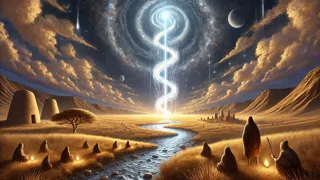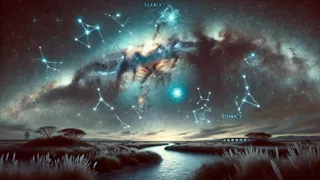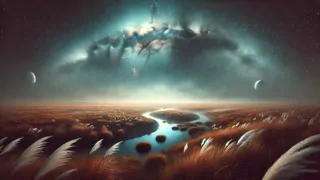Introduction
In the heart of Argentina’s vast pampas, where golden grasses sway beneath an endless sky, the legend of the Silver River has woven itself into the fabric of time. For countless generations, gauchos and villagers gathered under the stars to share tales of this luminous ribbon stretching from horizon to horizon, a celestial waterway flowing high above the earth. They say it is the Milky Way’s mortal reflection, a path forged by divine forces to link the world of humans with the realm of the gods. On quiet nights, travelers following the Rio de la Plata’s winding course pause to gaze aloft as the luminescent streak above mirrors their course below, reminding each soul of a love so fierce that even heaven could not restrain its surge. At the heart of this enduring myth lie two star-crossed lovers whose devotion challenged the boundary between earth and sky. United by a vow whispered beside the earthly river’s gentle rush, Elaria and Tomas swore to join their fates beyond the veil of mortality. But when the celestial river opened between their worlds, their joined hands were torn apart. This single act of heartbreak birthed the Silver River itself, a permanent barrier of shimmering light that split lovers, friends, and kin across the ages. Even now, the wind carries a distant melody along its banks—a mournful song that recalls promises broken and yearning hearts left behind. Visitors to the southern skies on clear winter evenings slow their breath as the river’s silver glow ignites dreams of reunion amid the cosmic expanse, a reminder that longing can carve legends as enduring as the stars themselves.
Origins of the Celestial Silver River
In the beginning, before the dawn of mortal kingdoms and before any footfall touched the soft pampa grass, the cosmos sang a song of creation that echoed across the void. From that melody emerged the Silver River, birthed by a convergence of cosmic energies and divine yearning. It was said that Solano, the sun god, poured his first light into a ribbon of liquid silver, granting it life as it spiraled down into the night sky. Each droplet carried the warmth of dawn and the cool hush of midnight, weaving together day and night into a single tapestry of luminescence. The river shimmered with a thousand hues of moonlight and starlight, its currents carrying the promise of unity between heaven and earth. As it took shape, the Silver River traced invisible paths through the heavens before settling into a majestic arch above the vast Argentine plains. Elder shamans spoke of the moment when the river first appeared, a luminous bridge uniting distant realms. The air trembled with power, and the earth itself bowed to the river’s radiance. Scholars in hidden desert temples recorded visions of ancestors stepping across its glowing banks, trembling with awe at the prospect of a journey beyond the stars. From that day forward, mortals gazed upward, tracing the river’s winding path and feeling the tug of something vast and eternal. The celestial river became a map of hope, guiding fishermen on moonlit lagoons and farmers who measured seasons by its shifting glow. Ochre-hued clay tablets uncovered near old ruins told of star scribes who recorded the river’s ever-changing courses, claiming it reflected the fate of kings and common folk alike. According to one fragile tablet, the river’s glow would flare in times of triumph and dim in moments of heartbreak, like a cosmic heart beating with mortal emotion. Travelers noted that on nights when the river shone most brilliantly, omens of birth and renewal followed, while faint whispers along its banks heralded storms of sorrow or loss. In villages scattered beneath its watchful glare, artisans sculpted riverine deities with arms outstretched, pleading for passage to realms unseen. Chanting rose in ceremonies beneath its course, voices weaving together in harmony with the river’s eternal current. Even the fiercest warriors would lay down their spear at the sight of its radiant flow, humbled by the vision of something greater than destruction or conquest. Thus, from the wellspring of celestial music to the hands of storytellers in remote outposts, the Silver River carried tales of origin and wonder, a narrative as fluid and boundless as the river itself.

Legends whisper that the Silver River chose its course with deliberate grace, deciding where to weave its silvery presence according to the rhythms of earth and sky. It began by tracing the Rio de la Plata’s winding channel as if to honor the river’s mortal twin, then curved southward to dance above the windswept pampas, where windmills turned in silent salute. In some versions of the myth, the river drifted north through dense subtropical jungles, brushing treetops and igniting bioluminescent flowers with its touch. Travelers spoke of nights when phosphorescent blooms would carpet hidden trails in soft light at the river’s command. Pilgrims made arduous journeys from mountain villages, following whispered rumors of its brightest arc, seeking healing or transcendence at specific skyward crossings. Priests and priestesses constructed open-air temples where offerings of silver trinkets and woven cloths were laid beside flickering braziers. They believed that guardians moved along the river’s banks, invisible yet ever-present spirits whose voices sounded like whispered miracles in the night wind. Among these celestial custodians, twin siblings Maika and Yuren stood apart, charged with preserving the river’s harmony. Maika was said to wear robes spun from starlight, her laughter like tinkling crystal, while Yuren cast gentle shadows that cooled the river’s shimmering heat. Together they taught mortals to listen when the river spoke, to read its silent currents like a sacred text. Their bond, unbroken even by time’s passage, became a parable for devotion that could transcend the boundaries of existence itself. Over centuries, the worship of Maika and Yuren waned in distant regions but never disappeared from the hearts of those who felt the river’s call. Shrine keepers passed down intricate carvings of the twins embracing over the river’s mouth, symbolizing the unity of dual forces. In the flicker of candlelight inside these sanctuaries, one could almost hear the dead murmuring their gratitude for a cosmic bond that offered both solace and challenge.
As ages passed and empires rose and crumbled beneath its luminous gaze, the Silver River became more than a bridge between worlds—it became a sacred test of devotion and endurance. Poets composed epic verses that compared mortal love to the river’s ceaseless flow, praising hearts that braved its distance. Kings commissioned astronomers to chart its every shimmer, believing the pattern of its light could reveal strategies for conquest or counsel on governance. In humble villages, lovers carved initials into nearby trees, pledging their loyalty under the watchful stream, only to return years later and find the carvings faded by time and weather. Wandering minstrels sang ballads of souls separated by the river’s expansion, tales woven with hope that their longing would one day reunite them. Yet in each of these stories, the river’s immutable will served as a reminder: for love to rise above its mortal constraints, it must endure the ache of absence. Even mighty heroes who sought to cross the river’s threshold were repelled by a glimmering barrier of light, their armor melting into starlight before they could breach its waters. Followers of the old faith learned that separation could carry its own blessing, that the very tension between meeting and parting concentrates emotion into something greater than itself. Travelers claimed that at the river’s zenith, just above certain sacred canyons, the stars themselves seemed to rain down in silver droplets, evoking both wonder and deep sorrow. This paradox—of beauty born from sorrow, of unity found in division—became the core lesson imparted by the Silver River. And so, beneath Argentina’s open heavens, its waters continue to flow, a living testament to the paradox of union and loss that has shaped countless souls, reminding every observer that every meeting carries within it the seed of separation, and every parting the promise of reunion in some other realm.
The Lovers’ Fateful Oath
In a small village nestled on the southern bank of the Rio de la Plata, a young weaver named Elaria spent her days crafting intricate cloth dyed with the pigments of sunset hues. Each evening, she climbed a weathered wooden stairway leading to a solitary lookout and watched as the sky drew down the veil of dusk. It was there, above the whispering rush of the river, that she first beheld the Silver River’s radiant glow. Legends said that those who gazed upon its birth felt a stirring deep within their soul, as if the cosmos recognized a kindred spirit. One such moonlit night, as Elaria traced the river’s luminous path with her fingertips, she found herself sharing that sacred place with another watcher. Tomas, a humble musician whose flute carried melodies shaped by longing and dreams, had journeyed from a distant valley. His eyes held curiosity that matched the river’s luminous arc, and when their gazes met, time felt suspended between two pulses. They spoke little at first, for words seemed too ordinary to honor what stirred between them. Instead, Tomas lifted his flute and coaxed a melody as gentle as the river’s flow. Elaria responded by unfolding a tapestry woven with silver threads, its design reflecting the arch above. Together, they wove sight and sound into a silent communion that transcended language, as if the Silver River itself had orchestrated their meeting in its celestial design. Night after night, they returned to the lookout, sharing fragments of their past and dreams of distant horizons. Elaria spoke of looms and dyes, of patterns inspired by the flight of birds across golden fields, while Tomas described mountain ridges peppered with spring blooms and horizons painted at dawn. With each exchange, their spirits intertwined, as if two rivers converging in a vast delta of hope. The Silver River above pulsed with brilliant intensity during those nights, its waves of starlight dancing across Elaria’s tapestry and reflecting on Tomas’ flute in luminous gleams. Neighbors observed the phenomenon with wonder: a new star seemed to appear at the river’s heart, pulsing in resonance with the lovers below. Elders whispered that the celestial current approved of their union, carrying their devotion across the heavens for all to witness. In the hush between their shared breath, Elaria and Tomas felt an unspoken promise forming, one that would bind them beyond the boundaries of earth and sky.

As the seasons turned, the bond between Elaria and Tomas deepened into a devotion that echoed the legends of old. Each dawn, they met at the river’s edge to collect tokens: a silver fern frond wetted by morning dew, a carved wooden flute inscribed with runes of protection. Together, they fashioned a ritual to honor the Silver River, placing their tokens upon a flat stone altar just as the first rays of sun touched the water’s edge. Casting a shared glance toward the heavens, they offered a vow: to remain united even if the world itself conspired to drive them apart. Their words were carried aloft by gentle breezes, weaving into the fabric of the river’s glow. Deep in the night, when the celestial current blazed its brightest, the guardians Maika and Yuren descended in forms of silver mist, their voices a chorus of gentle echoes. The twins bore witness to the lovers’ oath, nodding in solemn accord as if granting their blessing. Yet behind their measured gaze lay a quiet warning: no mortal heart could cross the boundary the Silver River upheld without sacrifice. Undeterred, Elaria and Tomas pressed forward, believing that the purity of their vow could sway even divine decree. The stars above shone with heightened brilliance that night, leaving trails of stardust in their wake, as if nature itself celebrated the promise they wove into eternity. In the days that followed, however, murmurs of caution rippled through their village. Some spoke of ancestors who vanished chasing after the river’s reflection, never to return. Others feared the wrath of the guardians, convinced that human love would never outrank divine order. Yet Elaria and Tomas found their courage in each other’s eyes, believing that shared destiny would outshine any celestial decree. Under the tapestry of stars, they crafted a final plan: at the next zenith of the Silver River’s glow, they would bind their souls in a ritual beneath its arch, defying the boundary that stood between mortals and the divine.
On the eve when the Silver River reached its zenith, the air itself shimmered with expectancy. Elaria and Tomas gathered at the lookout, their ceremonial tokens glowing softly in the hush before dawn. They traced circles in the dust with entwined fingers, chanting the ancient verse passed down by elders who spoke of world’s edge and star’s seam. In unison, they stepped forward, crossing the threshold where earth’s gentle murmur met the river’s silvery roar. At that moment, a powerful surge of radiant light enveloped them, and the guardians Maika and Yuren materialized in full splendor. Maika’s robes spun with star threads, and Yuren’s shadowed form pulsed with lunar grace. For a heart-stopping instant, the lovers believed the guardians would grant safe passage to unify their souls beyond the heavens. Then, with a voice that resonated across earth and sky, Yuren declared, Mortals may dream of bridging worlds, but some rivers remain unyielding. A beam of light arced between the guardians’ outstretched hands, striking the lovers’ clasped ones with blinding intensity. Elaria and Tomas cried out as both were torn from the earthly plane, their forms dissolving into sparks of silver flame that drifted upward. Villagers watched in horror and awe as the lovers ascended, transformed into twin constellations flanking the river’s luminescent flow. In their ascent, they uttered a final vow: to remain as guiding stars until the day when love alone could unite their spirits across the celestial divide. Shrouded beneath the river’s gleam, the guardians retreated into myth once more, leaving behind a legacy written in silver: a testament to the power of love, even when it defies the cosmic order. It is said that on nights when two shooting stars collide above the Silver River, the souls of Elaria and Tomas meet in the void between dreams and starlit reality, if only for a fleeting moment before once again parting at the will of the divine current. Thus, their fateful oath transformed the Silver River into an enduring symbol: a reminder etched across the heavens that some promises echo beyond the mortal coil, pulsing in each stardust trace that arcs through the Argentine sky.
Eternal Separation and the River’s Song
As the night sky settled into its eternal vigil, the transformation of Elaria and Tomas engraved itself across the firmament for all to witness. The Silver River’s arch shimmered with newfound clarity, and within its glow emerged two shimmering constellations facing each other across the celestial current. One cluster, softly radiant and woven from pale starlight, became known as Elaria’s Weave, recalling the tapestries she once spun of sunset hues. Opposite it, a bolder formation of stars glimmered like a melody frozen in motion, earning the name Tomas’ Song. Together, these twin constellations fluttered in harmony with the river below, their positions shifting ever so slightly with the turning seasons. Poets across Argentina traced the patterns in the sky, composing verses that compared the lovers’ starlit forms to lanterns guiding souls across dark waters. Ancient instruments, from wooden flutes to brass horns, attempted to capture the silent dialogue between these starry figures, though none could truly replicate the tender cadence of their bond. Fishermen at dawn watched the river’s reflection blend with the Milky Way, catching glimpses of Elaria’s gentle swirl and hearing the faint echo of Tomas’s flute play in the hush before sunrise. It was as if the couple’s love transcended mortality and time, weaving itself into the rhythm of the cosmos and inviting onlookers into a timeless embrace. Historians scoured old journals to find first mentions of the twin constellations, documenting changes in their brightness and orientation over centuries. Some scribes believed that during moments of great tragedy on Earth, the constellations dimmed in sympathy. Others claimed that lovers who pledged their hearts under the same starry pattern automatically found greater faithfulness and devotion. But always, poets and dreamers returned to the same refrain: the Silver River’s waters carried their story, and the sky answered back with starlight.

Down on the ground, where the earth bore the weight of human longing, the legend took root in countless rituals and customs. In remote mountain villages, elders lit narrow braziers along the river’s banks on nights when the constellation of Elaria’s Weave hung directly overhead. They released delicate paper lanterns—each bearing a painted star ray—to drift toward the river’s edge, whispering blessings for unity and protection. In the southern archipelagos of Tierra del Fuego, fishermen made offerings of shiny shells tied with crimson ribbons to small wooden boats set adrift at the water’s mouth, hoping the guardians Maika and Yuren would escort safe passage for both sea and soul. Gauchos rode their horses beneath the arching sky, singing laments in low, haunting tones, believing that the combined echo of hoofbeats and ballads would carry their voices to the twin stars. Families passing the tradition by candlelight would recount the moment when the lovers were torn apart, emphasizing that while the Silver River’s glow remained untouchable, its song played softly for every heart brave enough to listen. Artists carved wooden plaques of the river’s silhouette overlapped by two star clusters, hung in homes as a reminder of the paradox that binds union and separation into a single fabric of existence. Even in bustling Buenos Aires, city dwellers turned their eyes skyward when an eclipse dimmed the Silver River’s path, interpreting it as a rare moment to reflect on loss and hope. Musicians composed symphonies that attempted to mimic the river’s flow with crescendos and decrescendos, infusing each measure with notes that rose and fell like water. In dance halls of Córdoba, couples moved in tandem under projected stars, each step a tribute to Elaria’s Weave and Tomas’ Song. And in classrooms, teachers used the myth to spark children’s imaginations, encouraging them to draw maps of the celestial river and dream up new legends of what might lie beyond its banks. The cultural tapestry of Argentina became richer for the thread of the Silver River, weaving community, art, and devotion into one luminous narrative.
Yet despite the richness of tradition, the Silver River retains its air of solemn mystery, reminding every observer that some forces are beyond mortal understanding. Travelers who cross the Pampas still pause at sunset, seeking a final glimpse of the river’s ascent above the horizon. At high-altitude observatories in the Andes, astronomers record variations in starlight as if decoding the river’s secret language, hoping to interpret what the twins Elaria and Tomas might be trying to convey. In small chapels that dot the countryside, priests whisper prayers that implore the river to grant comfort to those who mourn, believing that the celestial water carries the healing balm of ancient devotion. Even the most pragmatic poet can feel a tremor of wonder when the Milky Way aligns with the river’s earthly twin, as if two worlds have momentarily drawn breath in unison. Some seekers journey during the solstice when the river’s glow lingers longer at dawn, viewing it as a sacred invitation to reconcile the tension between longing and acceptance. And so the Silver River’s song continues to wind through hearts and landscapes alike, an eternal refrain of love found and lost. As it has for countless generations, the celestial stream invites us to marvel at our place in the cosmos—to recognize that in every separation lies the promise of reunion, and that the brightest light often emerges from the deepest longing beneath Argentina’s open sky. Thus, the myth endures as both a lament and a hymn, a reminder that while some rivers may separate, the currents of devotion they inspire can chart a course beyond the boundaries of earth and sky.
Conclusion
In the soft hush that follows every night beneath the Silver River’s arch, there lingers a fragment of longing both timeless and profound. The myth of Elaria and Tomas, woven into the river’s luminous tides, endures as a testament to the enduring paradox of love—how union can arise from separation, and how the ache of absence lends strength to every heartbeat across the ages. From the vast pampas to the lofty peaks of the Andes, from quiet village shrines to bustling urban observatories, the celestial river sings its mournful yet hopeful melody. It reminds us that some barriers, however insurmountable, may yield to the purity of a vow uttered in devotion. Though mortals cannot wade through its silvery waters, they may journey within their own hearts, guided by the twin stars of loyalty and sacrifice. And should you ever find yourself beneath a sky where the Milky Way dips toward the horizon, pause to listen for a soft murmur carried on the wind—the enduring song of the Silver River, echoing the promise that all souls entwined in love will one day converge beyond the edge of the known world. May its light inspire us to honor every bond, however distant, until the day when all currents unite in a single, boundless sea of stars.



















